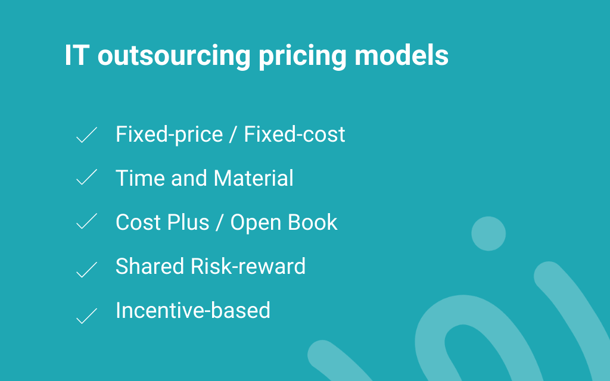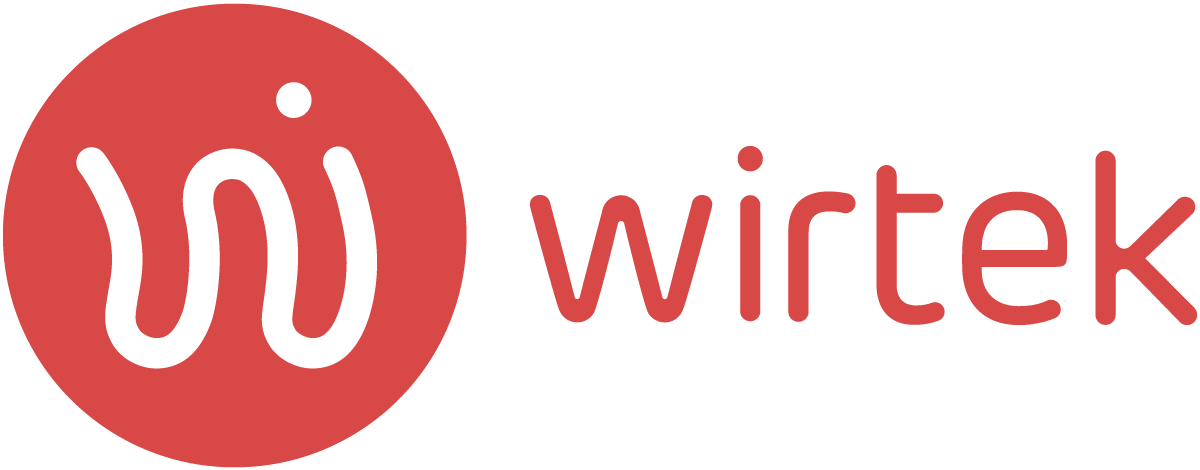- Blog
Sign up to our newsletter
Pricing models in IT outsourcing - which one is the right for you?
When you decide to outsource your software development or testing work, selecting the pricing model is just as an essential task as finding the right provider. You want to make sure you choose a trustworthy partner, with the right expertise and experience, with the right attitude and a healthy company culture. At the same time, you want to work with the pricing structure that makes most sense for your organization and type of work contracted, so you maximize your benefits.
In this article, we are going to look at the most popular pricing models in the IT outsourcing world. And then detail on the pricing models we use here at Wirtek, their pros and cons and how we help our clients pick the right one for them.
What are the different IT outsourcing pricing models available?

- Fixed-price / Fixed-cost - based on a well defined scope of work and requirements, the IT outsourcing vendor estimates the workload needed to complete the project and proposes a fixed budget. The fixed budget is typically made up of the volume of work multiplied by an hourly rate. It is a pricing model suited for developing rather simple applications, where the outsourcing provider manages the entire development process and so the responsibility over deliverables falls on its shoulders. Such a model ensures high predictability over budget and timing but very little flexibility in terms of adding or changing requirements.
- Time and Material - the IT provider invoices the amount of work delivered to the client at the end of the month. The parties can agree on an hourly or monthly rate per type of expertise or blended rate (a rate that covers different roles -developers, testers- and levels of seniority). This is a flexible model that is best suited for long term software development and maintenance projects: the scope of the project is not defined at the beginning of the collaboration and evolves over time. The IT outsourcing partner allocates the needed resources without the pressure of a fixed deadline and the client has the flexibility to change specifications based on evolving business needs or priorities.
- Cost Plus / Open Book - in this model the IT outsourcing provider invoices the actual expenses incurred for services plus a profit margin. This is a very transparent model and is most commonly used when building dedicated engineering teams (also called Dedicated Team fee). The expenses invoiced represent the cost with human resources, infrastructure, management and operational fees.
- Shared risk-reward - in this model, the provider and client agree on a target price for delivering a project and share both the risks or the reward. If the budget is exceeded, then the IT outsourcing vendor partially covers the extra cost, and the client supports the rest. If the provider manages to deliver the project on certain terms, there is a reward to be shared.
- Incentive-based - in this model the provider is rewarded with a bonus payment when they meet or exceed performance goals.
What are the pricing models we use in Wirtek?
We offer a few different pricing models to our clients that depend on the type of engagement they choose with us: Dedicated Teams or Project Services.
Dedicated Team Fee
In this model, we build dedicated engineering teams that work integrated with our clients’ in-house teams and charge a monthly fee for each engineer. This fee is made up of three main category of expenses:
- Salary cost plus taxes
- Benefits package: a sum allocated to various benefits we offer our team, such as healthcare insurance, gym membership, team activities
- Seat fee: this includes the cost for office rent, infrastructure maintenance, HR, operations and Wirtek’s own profit margin.
Essentially, the monthly fee is made up of the cost incurred by Wirtek plus our profit margin.
We offer total transparency to our clients, and they know exactly what their team members’ fees are made up of, how much each line of expense weights. Because the dedicated team acts effectively as our clients’ own engineers, we believe it’s important they understand the different costs: salary related cost, taxes and everything else that is included in their monthly fee.
With the monthly fee being so open, rather than a single number on an invoice, our clients are aware of salary increases, negotiations and can even give feedback.
The dedicated team model makes most sense when you are building complex applications, with specifications that are very likely to change and need ongoing development and testing. You retain a high control over the process and the product’s vision, and share responsibility over deliverables with the outsourcing partner. A close communication and transparent processes are key in dedicated teams, and so our pricing model makes no exception.
| Pros | Cons |
|
|
Project Services
When delivering Project Services, we can use one of the three models: Time and Material, Fixed Price, and Shared Risk-Shared Gain.
With Project Services, we charge an hourly rate for different types of roles (seniors, mid level engineers, juniors). Also, these hourly rates tend to be higher than if you calculated the hourly rate for a Dedicated Team. And that is because most of the risk will be on Wirtek’s side: only billable hours are invoiced (leaving Wirtek to cover vacation or sick days), and also gaps between projects are supported by us (the so called bench time, when engineers finishing a project have a gap until the next one).
1. Time and Material
This is a simple and commonly used model where the client assigns tasks to the team and pays for the hours spent in the project. Time and Material is a beneficial model when you don’t have very detailed specifications from the beginning and can change priorities or requirements very easily. You stay in control of where the project is heading.
When delivering services in this model, we use the Agile methodology and work in sprints to continuously deliver working features.
We charge our standard hourly rates and many of our clients that have a Dedicated Team setup use the Time and Material model for handling an increased workload (and sometimes for accessing a specific expertise that is not currently in the team).
| Pros | Cons |
|
|
2. Fixed Price
In this model, we commit to a fixed budget for delivering a software product that meets the client’s requirements. We estimate the workload needed to develop the project, based on well defined specifications.
As we work with a predetermined budget, any changes that come up will need to be discussed, estimated and together with the client we will need to agree on a new budget and timeline. This translates into overhead time on both ends.
With Fixed Price projects, we assume the whole responsibility for the deliverables and also handles the project management and execution. The hourly rates that we charge in a Fixed Price model reflect this risk and are higher than our standard ones.
This model can be a great fit when you build a relatively simple application, with well-defined requirements, that are unlikely to change. However, if the requirements are very fluid, a Fixed Price project can end up costing more than a Time and Material one, because of the overhead cost and time spent in discussing and estimating change orders.
|
Pros |
Cons |
|
|
3. Shared Risk-Shared Gain
When our clients have a clear image on the scope of work but still have some requirements that might fluctuate, then we can employ a hybrid model we call Shared Risk-Shared Gain. We make an estimation based on the known requirements and come up with a target budget as the base of what we expect the project to cost. If the project comes below this target budget, then we will share the savings with our client. However, if the project goes above the target, then the client pays a percentage of the extra billed hours (covering Wirtek variable cost, but with no profitability for us).
So essentially any gain or risk is being split between us and our clients.
| Pros | Cons |
|
|
The Shared Risk-Shared Gain model can be a good fit for clients that know most of the requirements they want developed and want some level of predictability, while still being able to have some flexibility.
How do we advise our clients in deciding on the best solution for them?
When we meet with a potential new client, we spend quite some time getting to know them and understanding their needs and business goals.
We try to understand the type of product that they want to build, what is the current status of the product, do they need ongoing development and testing or just for a defined period of time, do they have technical expertise in house, product expertise? What type of organization do they come from, what are their plans moving forward?
All these variables matter and when we understand them well we are able to guide our clients in making the right choice in terms of collaboration and pricing models.

